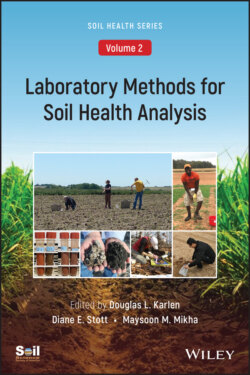Читать книгу Laboratory Methods for Soil Health Analysis, Volume 2 - Группа авторов - Страница 14
How Can a Farmer Assess Soil Health in the Field?
ОглавлениеMany producers are keen to learn about soil health on their farms and how they can alter their current soil and crop management practices to sustain or improve it. This interest has greatly increased opportunities for agricultural experts who can successfully bridge researcher and producer communities and is a key factor driving development of public and private programs that strive to strive for clear communication about soil health. For example, pasture and range scientists affiliated with the Noble Research Institute in Ardmore, OK, often advise farmers to consider five indicators (Jeff Goodwin, personal communication, 2018), which we summarize here as “the Five C’s of Soil Health”. They are:
Color– A healthy soil’s dark brown color indicates the presence of a lot of carbon in the form of decomposed organic matter. In contrast, gray, yellow, or mottled colors indicate soil that has a low carbon content, is poorly drained and poorly aerated, and likely low in nutrients available to plants.
Crumbs– A soil that is crumbly, like coffee grounds or cake crumbs, and holds that aggregate structure is likely in good physical condition supporting soil health. This is structure that allows water movement yet aeration, as well as root penetration. It holds up even when the soil is wet. If the dry soil can easily be ground to dust between the fingers, or it turns into a slick film when wet and rubbed between the forefinger and thumb, the aggregates are not stable and will not support a good crop.
Critters– A healthy soil shows lots of evidence of life. Pulling the crop debris back from the surface should reveal earthworms, or their holes and castings. Turning over the soil with a shovel should uncover insects, pillbugs, and other arthropods essential in carbon and nutrient cycling. A low‐power hand lens might allow observation of smaller arthropods such as mites that feed on debris and microbes, and perhaps even the filamentous hyphae of fungi or the near‐microscopic worms that feed on them. A soil that lacks evidence of diverse life is not healthy.
Cooperation, with roots, that is– A healthy soil does not constrain roots, its structure allows plant roots to grow vertically and laterally. When roots look stunted or turn at odd angles, it is likely that the soil is compacted or has a plow layer that obstructs root growth because it lacks good structure and aeration for a crop. Stubby, deformed, discolored, or rotten roots can also indicate the presence of parasitic nematodes, plant‐feeding insect pests, or pathogenic microbes in the soil, none of which is desirable for a healthy soil.
Cologne– A healthy soil has a fragrant, earthy aroma, indicative of the many aerated biological processes happening. A soil that has a sour or rotten‐egg odor is poorly aerated, probably because of poor structure and poor drainage, and is not likely to be a hospitable environment conducive to plant root development or beneficial microbes.
